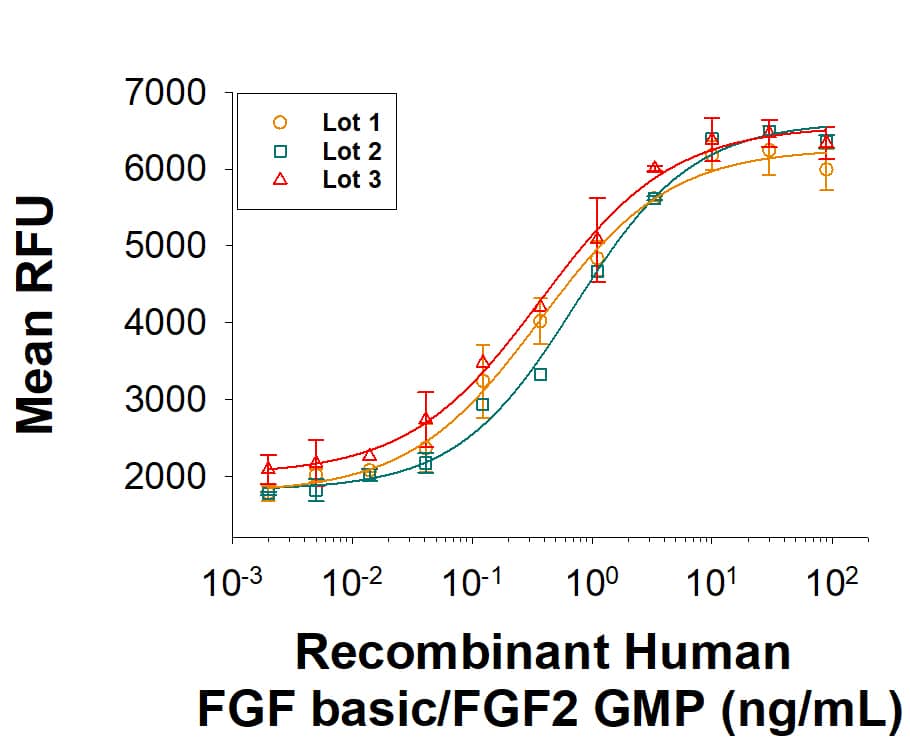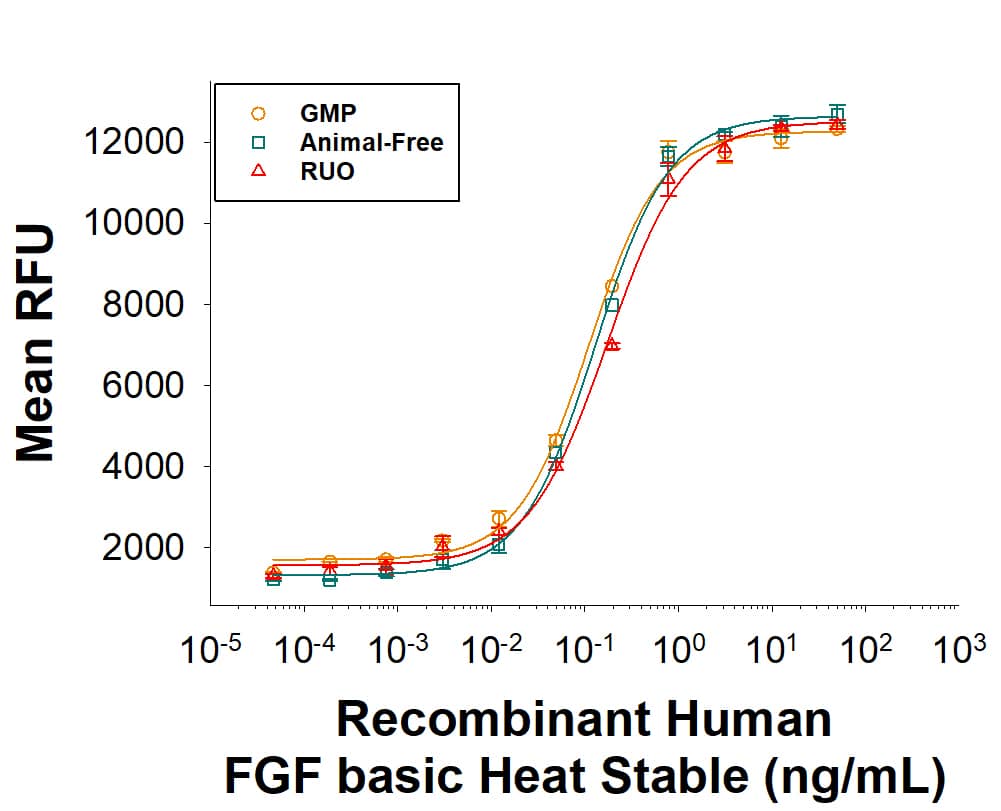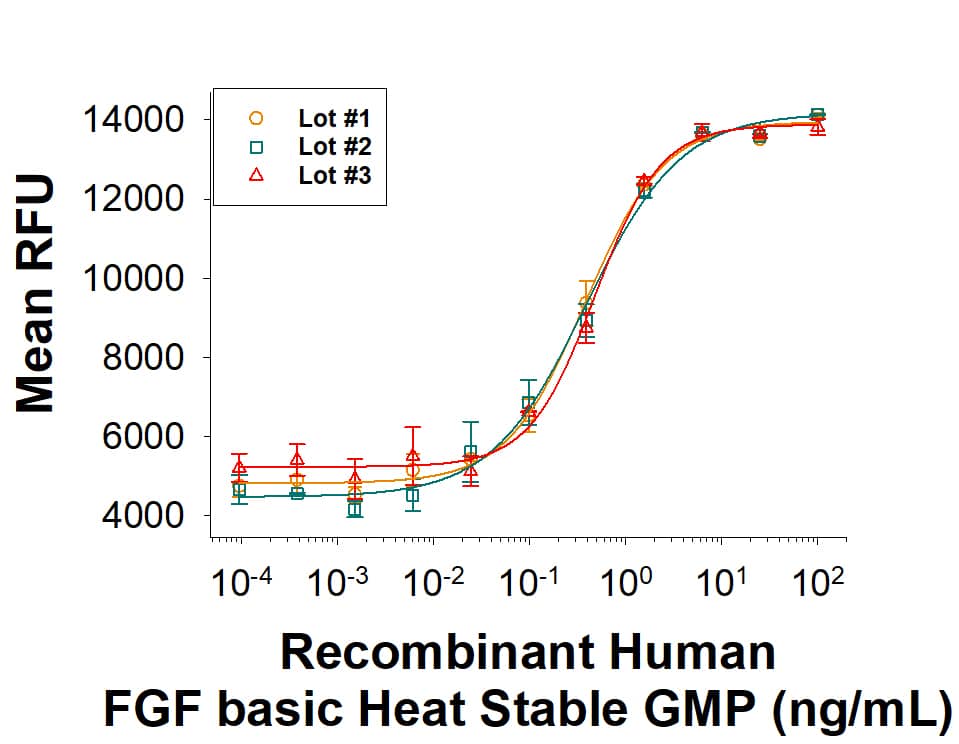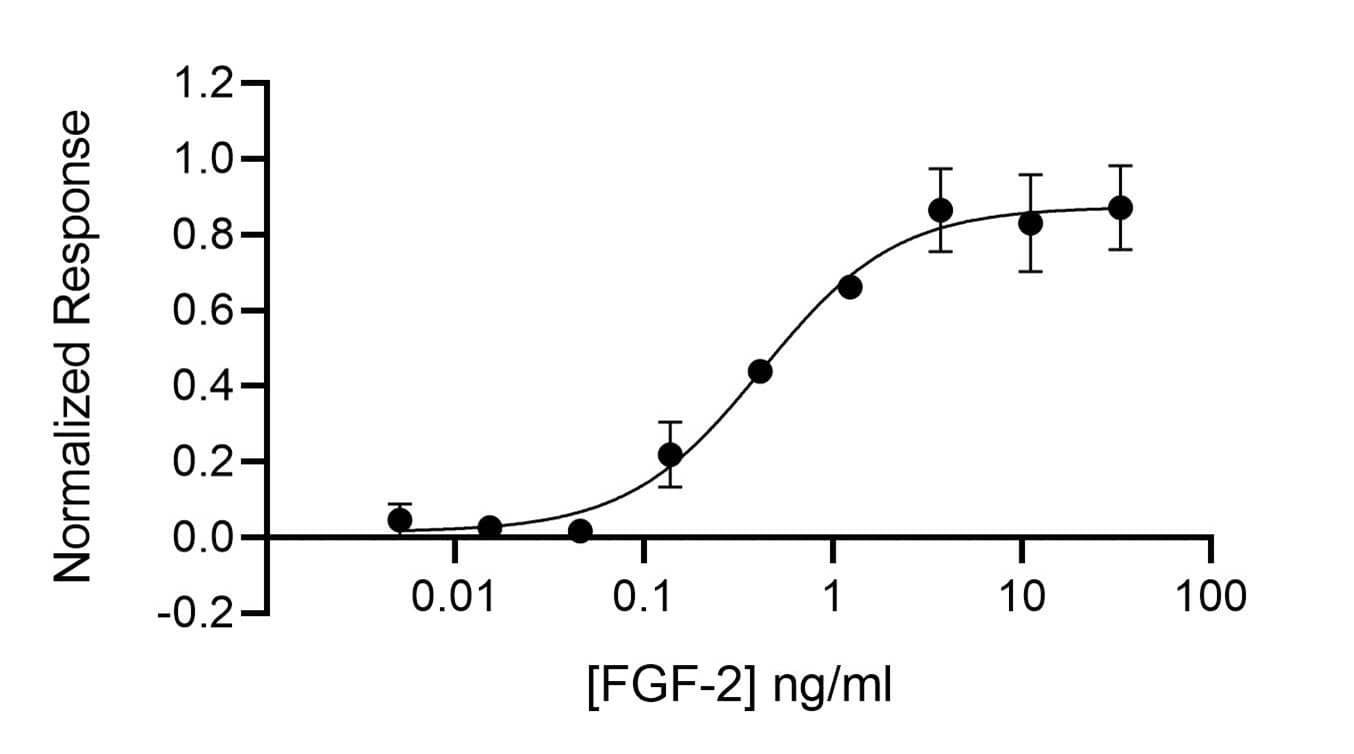FGF basic/FGF2/bFGF: Proteins and Enzymes
FGF basic/FGF2/bFGF is a growth factor that functions in angiogenesis, wound healing, tissue repair, learning and memory, and the morphogenesis of heart, bone, and brain. It is upregulated in response to inflammatory stimuli and in many tumors. FGF basic/FGF2/bFGF binds to FGFR1c and 2c. Its bioactivity is modulated by a number of other binding partners including heparin, Integrin alpha V beta 3, soluble FGFR1, FGF-BP, free gangliosides, Thrombospondin, Pentraxin 3/TSG-14, Fibrinogen, alpha 2-Macroglobulin, PDGF, and CXCL4/PF4. These molecules act as cellular coreceptors or adhesion partners, extracellular matrix decoys or reservoirs, and soluble scavengers or chaperones. In particular, the interaction of FGF basic/FGF2/bFGF with cell surface heparan sulfate proteoglycans (HSPG) is required for the binding and activation of FGF receptors.
25 results for "FGF basic/FGF2/bFGF Proteins and Enzymes" in Products
25 results for "FGF basic/FGF2/bFGF Proteins and Enzymes" in Products
FGF basic/FGF2/bFGF: Proteins and Enzymes
FGF basic/FGF2/bFGF is a growth factor that functions in angiogenesis, wound healing, tissue repair, learning and memory, and the morphogenesis of heart, bone, and brain. It is upregulated in response to inflammatory stimuli and in many tumors. FGF basic/FGF2/bFGF binds to FGFR1c and 2c. Its bioactivity is modulated by a number of other binding partners including heparin, Integrin alpha V beta 3, soluble FGFR1, FGF-BP, free gangliosides, Thrombospondin, Pentraxin 3/TSG-14, Fibrinogen, alpha 2-Macroglobulin, PDGF, and CXCL4/PF4. These molecules act as cellular coreceptors or adhesion partners, extracellular matrix decoys or reservoirs, and soluble scavengers or chaperones. In particular, the interaction of FGF basic/FGF2/bFGF with cell surface heparan sulfate proteoglycans (HSPG) is required for the binding and activation of FGF receptors.
| Source: | E. coli |
| Accession #: | NP_001997.5 |
| Applications: | BA |
Analyzed by SEC-MALS
| Source: | E. coli |
| Accession #: | NP_001997 |
| Applications: | BA, BA |
Intended for preclinical researchers who may transition to GMP FGF basic/FGF2 for their clinical work
| Source: | E. coli |
| Accession #: | NP_001997.5 |
| Applications: | BA |
| Source: | E. coli |
| Accession #: | NP_001997 |
| Applications: | BA |
| Source: | E. coli |
| Accession #: | P15655 |
| Applications: | BA |
| Source: | E. coli |
| Accession #: | E0AEV7 |
| Applications: | BA |
| Source: | E. coli |
| Accession #: | NP_001997.5 |
| Applications: | BA |
| Source: | E. coli |
| Accession #: | P13109 |
| Applications: | BA |
| Source: | Bovine Brain |
| Applications: | BA |
| Source: | E. coli |
| Accession #: | P03969 |
| Applications: | BA |
| Source: | E. coli |
| Accession #: | FIP6K6 |
| Applications: | BA |
| Source: | E. coli |
| Accession #: | P03969 |
| Applications: | BA |
Animal-Free.
| Source: | E. coli |
| Accession #: | NP_001997.5 |
| Applications: | BA |
| Source: | E. coli |
| Accession #: | NP_001997.5 |
| Applications: | BA |
| Source: | E. coli |
| Accession #: | NP_001997.5 |
| Applications: | BA |
| Source: | E. coli |
| Accession #: | AAI62367.1 |
| Applications: | BA |
| Applications: | Bioactivity, PAGE |
| Applications: | Bioactivity, PAGE |
| Applications: | Bioactivity, PAGE |
| Applications: | Bioactivity, PAGE |

















![SDS-PAGE: Recombinant Human FGF basic/FGF2/bFGF Protein [NBP2-34921] SDS-PAGE: Recombinant Human FGF basic/FGF2/bFGF Protein [NBP2-34921]](https://resources.bio-techne.com/images/products/Human-FGF-basic-FGF2-Protein-SDS-Page-NBP2-34921-img0001.jpg)
![SDS-PAGE: Recombinant Mouse FGF basic/FGF2/bFGF Protein [NBP2-35152] SDS-PAGE: Recombinant Mouse FGF basic/FGF2/bFGF Protein [NBP2-35152]](https://resources.bio-techne.com/images/products/Mouse-FGF-basic-FGF2-Protein-SDS-Page-NBP2-35152-img0001.jpg)
![SDS-PAGE: Recombinant Bovine FGF basic/FGF2/bFGF Protein [NBP2-34877] SDS-PAGE: Recombinant Bovine FGF basic/FGF2/bFGF Protein [NBP2-34877]](https://resources.bio-techne.com/images/products/Bovine-FGF-basic-FGF2-Protein-SDS-Page-NBP2-34877-img0001.jpg)
![SDS-PAGE: Recombinant Rat FGF basic/FGF2/bFGF Protein [NBP2-35239] SDS-PAGE: Recombinant Rat FGF basic/FGF2/bFGF Protein [NBP2-35239]](https://resources.bio-techne.com/images/products/Rat-FGF-basic-FGF2-Protein-SDS-Page-NBP2-35239-img0001.jpg)